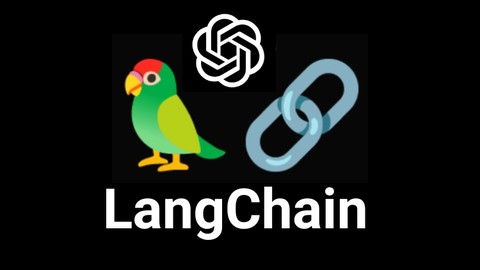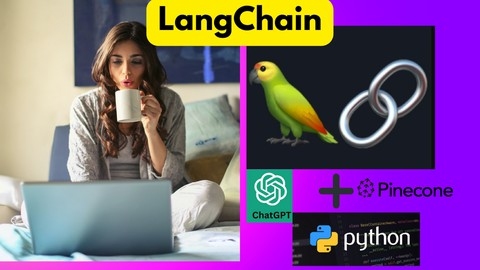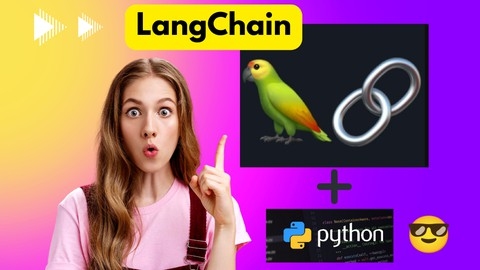LangChain is a powerful framework that allows you to build applications that leverage the capabilities of large language models (LLMs) like ChatGPT.
By combining LLMs with external data sources, tools, and memory, LangChain enables you to create sophisticated applications that can perform complex tasks, answer questions, summarize text, and much more.
Learning LangChain can open doors to exciting opportunities in the rapidly evolving field of AI, allowing you to develop innovative solutions and contribute to cutting-edge research.
Finding the right LangChain course on Udemy can be a daunting task, with so many options available.
You’re searching for a program that’s comprehensive, engaging, and taught by experts, but also aligns with your learning style and goals.
For the best LangChain course overall on Udemy, we recommend “LangChain- Develop LLM powered applications with LangChain.”
This course is a comprehensive guide that takes you from the basics of LangChain to building real-world applications.
You’ll learn how to set up your environment, use prompt templates, connect to various data sources, and implement chains and agents for powerful task automation.
The instructor, a seasoned developer, provides clear explanations and practical examples, making the learning process engaging and effective.
This is just the beginning of our exploration into LangChain courses on Udemy.
Keep reading to discover more recommendations for various learning levels, including options focusing on specific aspects of LangChain, like building chatbots, integrating with vector databases, and deploying your applications.
LangChain- Develop LLM powered applications with LangChain
The course starts by explaining the basics of LangChain, including its abstractions like chains and why it has become popular among developers.
You’ll learn to set up your development environment, configure tools like PyCharm and Git, and create your first LangChain application by chaining a simple prompt.
The course covers essential LangChain concepts like PromptTemplates, chat models, and chains through practical examples.
It then dives into a real-world project, building an “Ice Breaker” application that integrates with LinkedIn data.
You’ll learn web scraping techniques, work with external APIs like Twitter, and implement LangChain agents for autonomous task completion.
The course also covers output parsing to integrate with front-end applications using tools like Flask.
The course provides an in-depth understanding of ReAct agents, a core LangChain concept.
You’ll learn to define tools, implement LLM reasoning engines, and build a ReAct agent loop from scratch.
Furthermore, it introduces embeddings, vector databases like Pinecone, and chains like VectorDBQA and RetrievalQA for efficient data retrieval.
You’ll build a documentation assistant that can answer questions based on code documentation.
The course also covers advanced topics like building a slim ChatGPT code interpreter using agents and OpenAI functions.
It provides theoretical foundations for LLMs, prompting techniques (zero-shot, few-shot, chain of thought, ReAct), and memory management strategies in LangChain.
Throughout the course, you’ll work on practical projects, troubleshoot issues, and learn about the LLM application development landscape.
The instructor also shares useful tools like LangChain Hub and the TextSplitting Playground.
Learn LangChain, Pinecone, OpenAI and Google’s Gemini Models
The course starts by introducing you to LangChain.
You’ll learn how to set up the environment, work with chat models, cache responses, and use prompt templates.
The syllabus dives deep into LangChain’s core features like simple and sequential chains, agents, and tools like DuckDuckGo and Wikipedia.
You’ll even create a ReAct agent and test it in a Python REPL environment.
A significant portion focuses on integrating LangChain with vector databases like Pinecone.
You’ll learn about embeddings, authenticating to Pinecone, working with indexes and vectors, and performing similarity searches to answer questions based on your data.
Excitingly, the course covers Google’s Gemini multimodal models (Nano, Pro, and Ultra) and how to integrate them with LangChain for tasks like image analysis.
You’ll also explore safety settings and system prompts.
The projects seem hands-on and practical.
You’ll build a custom ChatGPT app from scratch, a Q&A app for your private documents using Pinecone or Chroma, and even create a front-end for the Q&A app using Streamlit.
Other projects cover summarization techniques and building a ChatGPT app with Streamlit.
Additionally, you’ll learn about Jupyter AI, a coding companion that can assist you while writing code in Jupyter Notebook or JupyterLab.
The appendices cover useful Python programming concepts, setting up Jupyter Notebook and Google Colab environments, and creating web interfaces with Streamlit.
LangChain with Python Bootcamp
You’ll start by learning how to use different models for text generation output and accepting inputs in LangChain.
This includes working with language models like OpenAI’s GPT models, chat models, and prompt templates.
The course then dives into connecting these models to various data sources.
You’ll explore document loaders for integrating with different file types, text embedding techniques, and vector stores for efficient data retrieval.
Additionally, you’ll learn about context compression and multi-query retrieval.
One of the core aspects covered is LangChain’s powerful chains, which allow you to combine models and other components for specific tasks.
You’ll work with chains like LLMChain, SimpleSequentialChain, SequentialChain, LLMRouterChain, TransformChain, and even chains for mathematical operations and question-answering over documents.
The syllabus also introduces memory concepts, enabling models to store and access previous information.
You’ll learn about objects like ChatMessageHistory, ConversationBufferMemory, and ConversationSummaryMemory, which can enhance the conversational abilities of your models.
Finally, you’ll dive into the exciting world of LangChain agents, which combine models, tools, and memory to perform complex tasks autonomously.
You’ll learn about agent basics, custom tools, and conversation agents.
Throughout the course, you’ll have opportunities to apply your knowledge through exercises and projects, ensuring a hands-on learning experience.
ChatGPT and LangChain: The Complete Developer’s Masterclass
This comprehensive course covers everything from the fundamentals of LangChain and ChatGPT to advanced topics like distributed text generation, custom retrievers, and self-improving text generation.
The syllabus starts by introducing LangChain and its capabilities through practical examples like PDF AI, a web application that integrates ChatGPT to answer questions about PDF content.
You’ll learn how to use LangChain to automate text-based applications, manage complex tasks like parsing PDFs, and interact with databases like Pinecone and Redis.
As you progress, you’ll dive into integrating ChatGPT with LangChain, exploring chains, prompt templates, and memory management techniques.
The course covers advanced topics like embedding techniques, custom document retrievers, and enhancing ChatGPT with tools and agents, allowing you to build sophisticated applications that leverage language models effectively.
One standout feature is the focus on building real-world projects, such as a web-based PDF chat application and an e-commerce database integration.
You’ll learn to handle file uploads, generate embeddings, store them in vector databases like Pinecone, and implement distributed text generation with Celery for efficient background processing.
The course also covers custom message histories, streaming text generation, self-improving text generation through component randomization and user feedback, and implementing tracing and observability with tools like Langfuse.
Additionally, you’ll learn to extend LangChain’s functionality by creating custom classes and mixins.
Throughout the course, you’ll work with various programming concepts like multithreading, concurrency, synchronization, and debugging techniques.
The syllabus covers essential tools and libraries like Redis, SQLite, Jupyter notebooks, and Python libraries like argparse and functools.
LangChain 101 for Beginners (OpenAI / ChatGPT / LLMOps)
This course starts with an overview of LangChain and OpenAI, guiding you through calling prompts with large language models (LLMs) like ChatGPT.
You’ll learn about using different LLMs, prompt templating, and chaining techniques.
The course dives into sequential chains, action agents that can take actions beyond just analyzing text, and even incorporating human input as a tool.
It covers advanced topics like plan and execute agents, which can dynamically determine what steps to take based on an objective.
Memory management is crucial for building chatbots and other conversational AI applications.
You’ll learn how to store and retrieve chat history, enabling context-aware responses.
The syllabus also covers document loading and retrieval chains, which allow you to work with large document sets efficiently.
Throughout the lectures, you’ll gain hands-on experience with LangChain’s powerful URL capabilities for integrating external data sources and APIs.
The course is designed for beginners, making complex concepts accessible through clear explanations and practical examples.
Master LangChain Build #16 AI Apps-OpenAI,LLAMA2,HuggingFace
The course starts with an introduction to LangChain and OpenAI, guiding you through API key generation and setting up the environment.
You’ll then dive into LangChain’s core modules like Models, Prompts, Memory, and Retrieval/Data Connection, with practical implementations in Python.
The real strength lies in the diverse projects you’ll build.
At the beginner level, you’ll create apps like a Simple Question & Answer App using OpenAI, a Conversational App with OpenAI Chat, and a Find Similar Things App for kids using OpenAI Embeddings.
These hands-on projects will solidify your understanding of LangChain’s fundamentals.
As you progress to the intermediate level, you’ll tackle more complex tasks like building a Quiz MCQ Creator App with Pinecone and Transformers Model, and a CSV Data Analysis Tool using OpenAI.
You’ll also explore LangChain’s Chains and Agents modules, which are essential for building advanced applications.
The advanced level projects are truly impressive.
You’ll build a YouTube Script Writing Tool with OpenAI and DuckDuckGo, a Support Chat Bot for your website using Pinecone and web scraping, and an Automatic Ticket Classification Tool with an SVM ML Model and Pinecone.
Additionally, you’ll create an HR Resume Screening Assistance app with Streamlit and OpenAI.
The course also introduces you to LLAMA 2, a powerful language model.
You’ll build projects like an Email Generator App, an Invoice Extraction Bot, and a Text to SQL Query Helper Tool using LLAMA 2.
Interestingly, the syllabus includes a project that integrates OpenAI with Zapier for a Customer Care Call Summary Alert system.
There are also bonus projects like a Code Review Analyst App with OpenAI.
LangChain MasterClass- OpenAI LLAMA 2 GPT LLM Apps|| Python
This course covers a comprehensive journey through LangChain, starting with an introduction to the library and its benefits.
You’ll learn about OpenAI and how to generate an API key, setting up the development environment with Anaconda.
The course dives into LangChain’s core modules like Models, Prompts, Memory, and Data Connections, with practical Python implementations.
The real value lies in the projects you’ll build.
At the beginner level, you’ll create apps like a Question Answering system, Conversational Chatbot, and a “Find Similar Things” app for kids using embeddings.
You’ll also build a Marketing Campaign app, integrating a frontend with the LangChain backend.
As you progress to intermediate projects, you’ll develop a Quiz MCQ Creator, CSV Data Analysis Tool, and explore LangChain’s Chains and Agents modules.
The advanced projects are where things get really exciting - you’ll build a YouTube Script Writing Tool, Support Chatbot for websites, Automatic Ticket Classification Tool, and an HR Resume Screening Assistant.
The course also introduces LLAMA 2, OpenAI’s latest language model.
You’ll use LLAMA 2 to create an Email Generator app, Invoice Extraction Bot, and even a Text to SQL Query Helper Tool.
Additionally, you’ll learn to integrate with services like Zapier for a Customer Care Call Summary Alert system.
The projects cover a wide range of use cases, from simple apps to complex tools, giving you a well-rounded understanding of LangChain’s capabilities.
Learn LangChain: Build #22 LLM Apps using OpenAI & Llama 2
The course starts by introducing you to generative AI and large language models like OpenAI’s GPT models.
You’ll learn about the transformer architecture that powers these models and how to design prompts for effective interaction.
The course then dives into LangChain, a framework that allows you to connect language models with external data sources like PDFs, websites, and databases.
One of the highlights is the extensive project-based learning approach.
You’ll build over 20 different applications, including a YouTube script writer, a PDF chatbot, a website chatbot, and even a medical chatbot using Llama 2 and Pinecone.
The projects cover a wide range of use cases, from summarizing videos and documents to generating multiple-choice quizzes and analyzing source code.
Along the way, you’ll learn how to fine-tune Llama 2 on custom data, run it on CPU machines, and integrate it with tools like Streamlit and Gradio for creating user interfaces.
The course also covers other models like Google’s PaLM 2 and explores alternative libraries like LlamaIndex.
LangChain: Develop AI web-apps with JavaScript and LangChain
The syllabus covers a wide range of topics, from setting up your development environment to deploying your applications on platforms like Vercel.
You’ll start by installing the necessary tools and configuring your API keys for services like OpenAI.
The course provides a quick start guide to help you write your first lines of LangChain code.
It also includes optional lectures on React, Next.js, and Tailwind CSS for those unfamiliar with these technologies.
The real fun begins with the hands-on projects.
The first project involves building a memory application that demonstrates how to connect the frontend and backend using Next.js.
You’ll learn about streaming responses from the backend, which is useful for chatbots.
Next up is a PDF chatbot project, where you’ll work with Pinecone, a vector database, to create a chatbot that can answer questions based on the content of a PDF file.
You’ll learn about embeddings, text splitters, and vector database question-answer chains.
The YouTube chatbot project teaches you how to build a chatbot that can answer questions based on the transcript of a YouTube video.
You’ll use the YouTube Transcript API, ChatOpenAI, and the ConversationalRetrievalQAChain from LangChain.
In the AI content generator project, you’ll create an application that can generate content based on a YouTube video and web search results.
You’ll work with tools like SerpAPI and the Web Browser Tool from LangChain, as well as the Zero Shot Agent.
The RoboHR project is a resume management system that uses LangChain to convert resumes to embeddings, store them in a vector database (like Pinecone or Supabase), and allow users to search and summarize resumes.
If you’re interested in deploying your applications, the course includes an optional chapter on uploading your code to GitHub and deploying it on Vercel.
Introduction to LangChain
The course kicks off with an introduction to LangChain’s basics, covering essential concepts like LLMs, chains, prompt templates, and output parsers.
You’ll learn how to set up your Python environment and work with Jupyter Notebooks (optional).
Next, you’ll dive into loading and summarizing data using LangChain.
This includes techniques for loading various data sources and employing different summarization strategies to condense information effectively.
Prompt engineering fundamentals form a crucial part of the course, where you’ll explore elements of a prompt, few-shot learning, memetic proxy, chain of thought, self-consistency, inception, self-ask, ReAct, and plan and execute techniques.
These concepts are essential for crafting effective prompts and enhancing the performance of your LLM-based applications.
The course then delves into vector database basics, explaining the importance of vector databases, similarity metrics, indexing techniques like product quantization, locality sensitive-hashing, navigable small world, hierarchical navigable small world, and maximum marginal relevance.
Understanding these concepts will help you optimize data retrieval and enhance the overall performance of your applications.
Retrieval augmented generation is a key topic covered, where you’ll learn how to augment LLMs with additional data from databases.
This includes indexing data, loading it into vector databases, providing sources, indexing websites and GitHub repositories, and employing strategies like stuff, map-reduce, refine, and map-rerank.
The syllabus also covers RAG (Retrieval Augmented Generation) optimization and multimodal RAG, introducing concepts like multi-vector retriever, hypothetical queries, parsing multimodal documents, summarizing data, describing images with LlaVA, and indexing data into databases.
Augmenting LLMs with a graph database is another exciting topic, where you’ll learn about knowledge bases, creating graph representations, and using tools like the Diffbot Graph Transformer and local graph databases to enhance LLM capabilities.
The course further explores augmenting LLMs with tools, introducing the concept of agents, building custom tools, and dissecting the iterative process involved in agent-based systems.
Practical applications are also covered, such as building a smart voice assistant by integrating speech-to-text and text-to-speech capabilities, creating a conversational agent, and augmenting it with tools.
Additionally, you’ll learn how to automate writing books by formalizing the writing process, creating main characters, plots, chapters, and events, and ultimately generating the book content using LangChain.
Finally, the course touches upon automating writing software by defining technical requirements, class structures, file structures, file paths, and iteratively generating code using LangChain.










